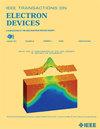Optimization of Electrical Properties for Vertical Vacuum Diodes With Multiregion Electron Emission Structures
IF 3.2
2区 工程技术
Q2 ENGINEERING, ELECTRICAL & ELECTRONIC
引用次数: 0
Abstract
Vertical nanoscale channel vacuum diode (VNCVD) with multiregion electron emission structures was constructed using ion beam etching and photolithography. The influence of multiregion electron emission on the electrical characteristics of VNCVD was investigated through simulations and experiments. Compared with the conventional annular single-region electron emission structure, the proposed multiannular design increases the number of emission regions and effectively expands the electron transport channel within the same plane. The optimized triple-ring electron emission structure possesses an emission current of具有多区域电子发射结构的垂直真空二极管的电学性能优化
采用离子束刻蚀和光刻技术制备了具有多区电子发射结构的垂直纳米通道真空二极管(VNCVD)。通过仿真和实验研究了多区域电子发射对VNCVD电学特性的影响。与传统的环形单区域电子发射结构相比,多环形设计增加了发射区域的数量,有效地扩展了同一平面内的电子传递通道。优化后的三环电子发射结构在大气条件下,在偏置1.1 V (n型Si阴极)下的发射电流为$1~\mu $ A。提出了多环效应和互层电场叠加是多环结构中发射电流增强的主要原因。在多环结构设计中,应选择合理的环间距($\gt 2~ $ mu $ m),以避免产生场屏蔽效应。本研究展示了一种有效提高电子发射性能的纳米级多通道真空二极管,为高性能真空微电子器件的发展铺平了道路。
本文章由计算机程序翻译,如有差异,请以英文原文为准。
求助全文
约1分钟内获得全文
求助全文
来源期刊

IEEE Transactions on Electron Devices
工程技术-工程:电子与电气
CiteScore
5.80
自引率
16.10%
发文量
937
审稿时长
3.8 months
期刊介绍:
IEEE Transactions on Electron Devices publishes original and significant contributions relating to the theory, modeling, design, performance and reliability of electron and ion integrated circuit devices and interconnects, involving insulators, metals, organic materials, micro-plasmas, semiconductors, quantum-effect structures, vacuum devices, and emerging materials with applications in bioelectronics, biomedical electronics, computation, communications, displays, microelectromechanics, imaging, micro-actuators, nanoelectronics, optoelectronics, photovoltaics, power ICs and micro-sensors. Tutorial and review papers on these subjects are also published and occasional special issues appear to present a collection of papers which treat particular areas in more depth and breadth.
 求助内容:
求助内容: 应助结果提醒方式:
应助结果提醒方式:


